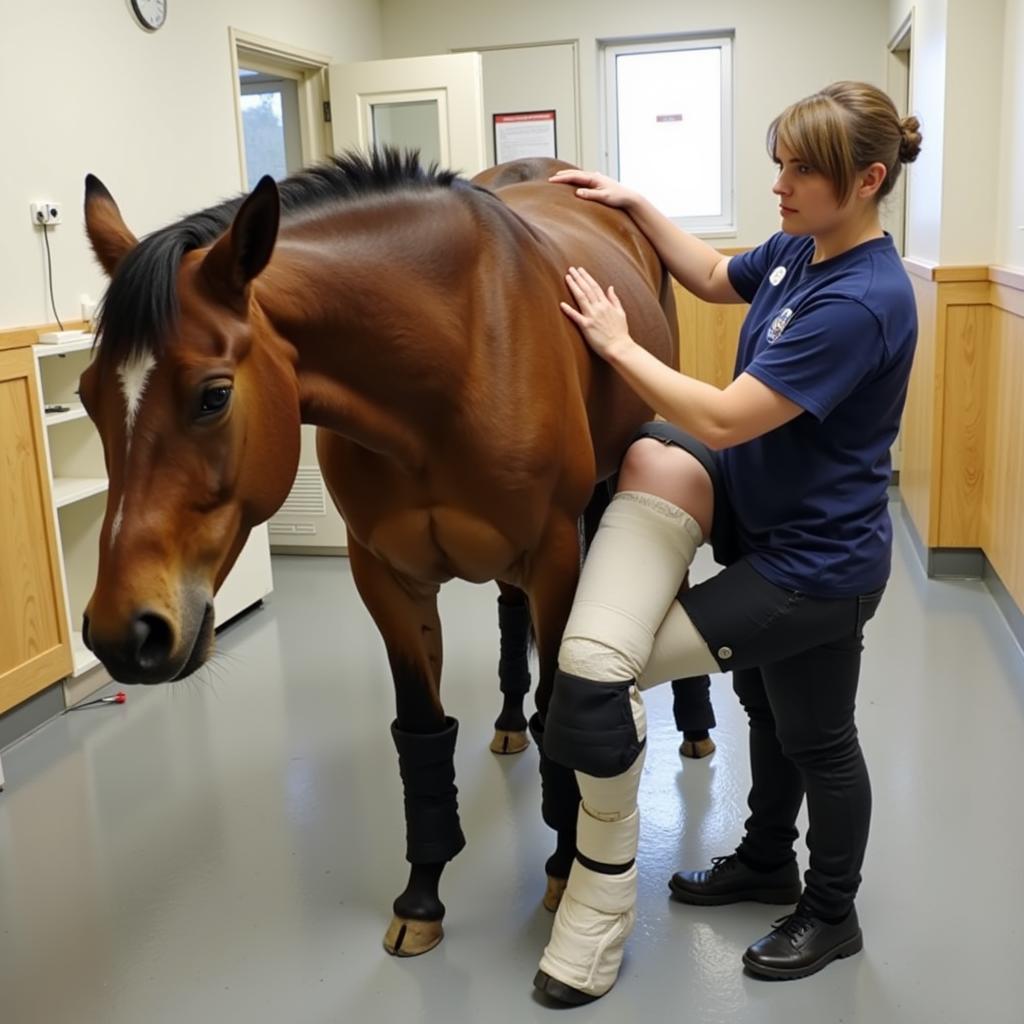Horse Pain Killers are essential tools for managing equine discomfort and ensuring the well-being of our equine companions. Understanding the different types, proper usage, and potential risks is crucial for responsible horse ownership. This comprehensive guide will explore everything you need to know about horse pain killers, from common ailments to administering medication safely.
Choosing the Right Horse Pain Killer
Several factors influence the selection of appropriate horse pain killers. The type and severity of the pain, the horse’s age and overall health, and any underlying medical conditions all play a role. For example, a mild strain might respond well to a non-steroidal anti-inflammatory drug (NSAID) like phenylbutazone (“bute”), while more severe pain, such as that associated with colic or surgery, may require stronger opioids. Always consult with a veterinarian for accurate diagnosis and treatment recommendations. They can assess your horse’s specific needs and prescribe the correct medication and dosage. Never self-medicate your horse, as this can lead to serious complications.
Common Types of Horse Pain Killers
There are various types of horse pain killers available, each with its own mechanism of action and intended use. NSAIDs are commonly used for musculoskeletal pain and inflammation. They work by inhibiting the production of prostaglandins, which are involved in the inflammatory response. Examples include phenylbutazone, flunixin meglumine (Banamine), and firocoxib (Equioxx). Opioids, such as butorphanol and morphine, are reserved for severe pain and are often used post-operatively or in cases of colic. They work by interacting with opioid receptors in the brain and spinal cord to reduce pain perception. Other options include corticosteroids like dexamethasone horses dosage, which are potent anti-inflammatories, and local anesthetics, which are used to numb a specific area.
Safe Administration of Horse Pain Killers
Proper administration of horse pain killers is vital for both safety and efficacy. Always follow your veterinarian’s instructions carefully. Oral medications, like bute paste, should be administered directly onto the horse’s tongue to ensure it is swallowed. Injectable medications require proper sterile technique and knowledge of intramuscular or intravenous injection sites. Incorrect administration can lead to complications such as abscesses, tissue damage, or even accidental overdose. If you are unsure about how to administer a medication, ask your veterinarian for a demonstration or consider using a humane horse twitch to ensure the safety of both you and your horse.
Recognizing Pain in Horses
Horses are masters at masking pain, making it crucial for owners to be vigilant and observant. Subtle signs of discomfort, such as changes in behavior, gait, or appetite, can indicate underlying pain. A horse experiencing pain may become withdrawn, irritable, or exhibit decreased performance. Lameness, stiffness, or reluctance to move can be more obvious indicators of musculoskeletal pain. Changes in vital signs, such as an elevated heart rate or respiratory rate, can also be indicative of pain.
“Early recognition and intervention are key to managing pain effectively,” says Dr. Emily Carter, DVM, specializing in equine sports medicine. “The sooner we address the underlying cause, the better the outcome for the horse.”
Long-Term Pain Management in Horses
 Horse undergoing rehabilitation therapy for pain management
Horse undergoing rehabilitation therapy for pain management
For chronic conditions requiring long-term pain management, a multimodal approach is often necessary. This may involve a combination of medication, physical therapy, and alternative therapies such as acupuncture or chiropractic care. Regular monitoring by a veterinarian is essential to adjust the treatment plan as needed and ensure the horse’s comfort and well-being. “A holistic approach, addressing both the physical and emotional needs of the horse, is crucial for successful long-term pain management,” adds Dr. Carter. This includes providing a comfortable and supportive environment, ensuring proper nutrition, and minimizing stress. Remember to learn more about specific pain killers in our dedicated guide to horse pain killers.
Conclusion
Horse pain killers are valuable tools in managing equine pain and discomfort. Understanding the various types, proper usage, and potential risks is vital for responsible horse ownership. By working closely with your veterinarian and staying informed about pain management strategies, you can ensure your horse receives the best possible care and maintains a high quality of life. Remember, early detection and intervention are crucial for effective pain management.
FAQ
- What are the most common horse pain killers?
- How do I know if my horse is in pain?
- Can I give my horse human pain killers?
- What are the side effects of horse pain killers?
- How long can a horse stay on pain medication?
- What are some alternative therapies for horse pain management?
- When should I call the vet for my horse’s pain?
For further assistance, please contact us at Phone Number: 0772127271, Email: [email protected] Or visit us at: QGM2+WX2, Vị Trung, Vị Thuỷ, Hậu Giang, Vietnam. We have a 24/7 customer service team.